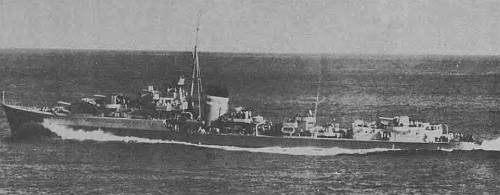- Author
- Pacini, John
- Subjects
- Ship histories and stories
- Tags
-
- RAN Ships
- HMAS Quickmatch, HMAS Napier, HMAS Nepal, HMAS Nizam, HMAS Quiberon
- Publication
- September 1974 edition of the Naval Historical Review (all rights reserved)
Although the hospital ship could not be attacked the destroyer was legal game for any submarine which should happen to be in the area.
The disposition could not be wirelessed, because also under the conventions no hospital ship can receive a cyphered message, and obviously the new disposition could not be sent in plain language, because it would be almost asking the Japanese to attack us.
At 7 p.m. on July 18 the Nepal was detached from the British supply force, which she had been helping to guard, and told to contact the Tjitjalenka, and direct her to the new fuelling area.
At 3 a.m. next day the Nepal arrived at an area where the Tjitjalenka should have been. Because of bad weather, sights on the sun had not been obtainable from the destroyer for several days, and the visibility on this day was bad. A heavy swell rose from the southwest, confining the search to a small area.
A few minutes after 8 p.m. the radar operator reported an echo on the port bow, and a little while later the glow from the hospital ship’s lights showed on the horizon. Identification was established, and the Nepal handed on the new orders, drawing away at a maximum speed to rejoin the fuelling force.
It knew the force would rendezvous to a certain position next day at 3 a.m., but it could not reach this point for some six or seven hours. Meanwhile the fuelling force’s course and speed could have changed without the Nepal being notified. At 6 a.m. next day the destroyer adjusted its course, and, pressing on as fast as the weather would allow, began a search plan.
Three hours later an American carrier plane flew overhead, and with it the Nepal established wireless communication. As it circled the Nepal asked for, and received, the bearing of what the pilot referred to as ‘Churchill’s boys’. Two hours later the Nepal joined an American destroyer, and eventually joined the fuelling force.
The Nepal’s effort was a stout one, because she had been unaided in her search, and was beginning to run short of fuel.
A few days after the incident, the Napier was given a similar assignment, but was accompanied by a small British aircraft carrier which had on board seven stretcher cases requiring urgent medical attention. After two days of almost constant air search, the hospital ship was sighted at dusk. We went alongside the hospital ship next day, and after passing stretcher cases aboard to us the carrier left us to rejoin the fuelling area.

Passing the sick men to the hospital ship was a ticklish operation to avoid making their journey, in their stretchers with built-up sides, any longer than necessary. At one stage the Napier was rolling only 20 feet away from the green hull of the mercy liner. As the first patient was being hauled across by the Javanese seamen on the hospital ship, it began to pour with rain, which lasted until the last man was passed over.




